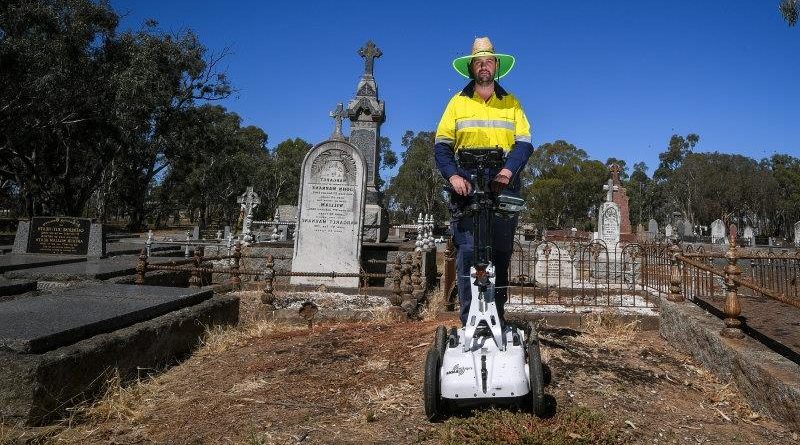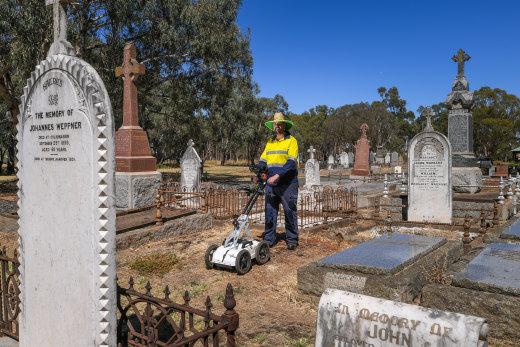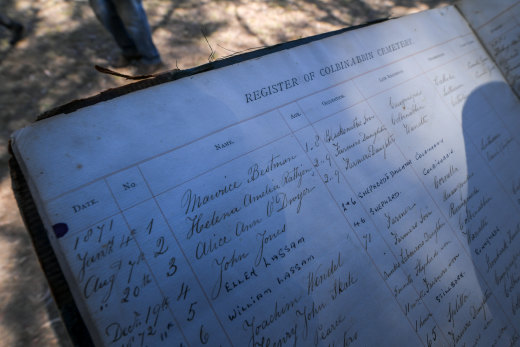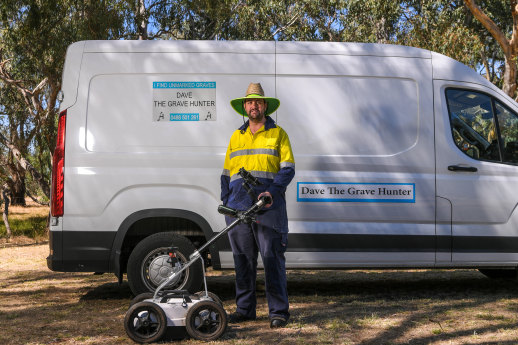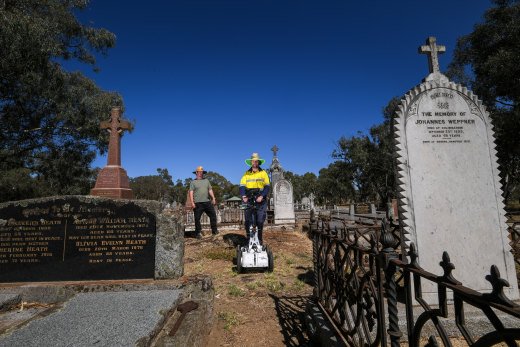When a cemetery loses the plot, Dave the Grave Hunter comes to the rescue
At 3am, when it’s pitch dark in a lonely country cemetery, you might find Dave the Grave Hunter at work.
He’s not a hooligan or a paranormal enthusiast. He’s there to work.
David Hunter, aka Dave the Grave Hunter, looking for vacant graves at Colbinabbin Cemetery.Credit:Justin McManus
The nickname on his van might cause double-takes on the road, but David Hunter really does find graves for a living. Cemetery trustees call his company, Hunter Geophysics, when they literally lose the plot: they simply don’t know where all their graves are.
If 40-degree weather or a storm is forecast by day, Hunter and his colleague Rod Hitchcock work at night, sometimes into the early hours.
That’s when the wolf spiders come out. One night last week, at Colbinabbin Cemetery 55 kilometres north-east of Bendigo, the men shone lamps across the graves, and an army of spider eyes shone back.
It looked like moving stars, says Hitchcock. At another cemetery, in the daytime Hitchcock spotted, on the edge of a grave 1.5 metres away from Hunter, a big brown snake.
“It took three or four minutes for my heart to calm down before I realised it was the six feet long skins of two brown snakes,” Hitchcock says. However, “the skins had just been shed — they were soft and shiny”.
Locals informed them that if they were bitten by a snake, the wait for an ambulance would be 45 minutes.
As for ghosts, one night Hitchcock felt a branch hold him back, but there were no trees nearby. Both men say ‘hello’ and ‘goodbye’ to cemetery occupants at each end of the day.
Wasp and bull ant stings are an occupational hazard, but the men enjoy being in the bush, among kangaroos, birds and sometimes beautiful gardens.
The ledger that records 600 Colbinabbin burials – pictured is the first burial, a toddler who drowned in 1871.Credit:Justin McManus
Hunter, 34, says it’s satisfying helping mostly rural communities — in 15 years he has worked at about 100 cemeteries across Australia — with a grave problem. “They appreciate that we’re able to do this,” he said.
A ledger kept for Colbinabbin Cemetery lists names of 600 burials from 1871.
But it doesn’t specify graves’ locations and there is no map. Over 100 graves don’t have headstones or cast iron markers.
A volunteer trustee of Colbinabbin Cemetery, Carmel Turner, says until Hunter’s work was finished, they were “not confident in selling plots in a few areas of the cemetery because we don’t know if somebody is buried there”.
David Hunter with the ground penetrating radar and his distinctively labelled van.Credit:Justin McManus
Hunter and Hitchcock, both qualified archaeologists, don’t use shovels or excavators. They use ground penetrating radar, pushing a machine resembling a lawnmower over unmarked plots and open ground.
Later, they evaluate the radar images but rather than human remains, it’s layers of soil and shapes they see on computer that tell them the story.
If the ground has been disturbed in the past and has the distinct shapes of plots, they can direct cemetery staff to mark them not to dig there.
If there is no disturbance, the plot is deemed vacant and the ground can be sold for burials or built-on.
Rod Hitchcock, left, and Dave Hunter at Colbinabbin Cemetery.Credit:Justin McManus
Hunter says without this technology, cemeteries’ staff may have to dig to see if a grave is vacant, and sometimes find coffins, which is traumatising.
Annie De Jong, president of the Cemeteries and Crematoria Association of Victoria and CEO of Ballarat Cemeteries, said in eras such as the gold rush, graves of the poor often had no headstones or other markers.
Sometimes records were lost or fires destroyed monuments.
De Jong said there are nearly 500 cemeteries in Victoria and ground penetrating radar is “a great tool to give you an idea of where you might have land that you can use”.
The Morning Edition newsletter is our guide to the day’s most important and interesting stories, analysis and insights. Sign up here.
Most Viewed in National
From our partners
Source: Read Full Article
